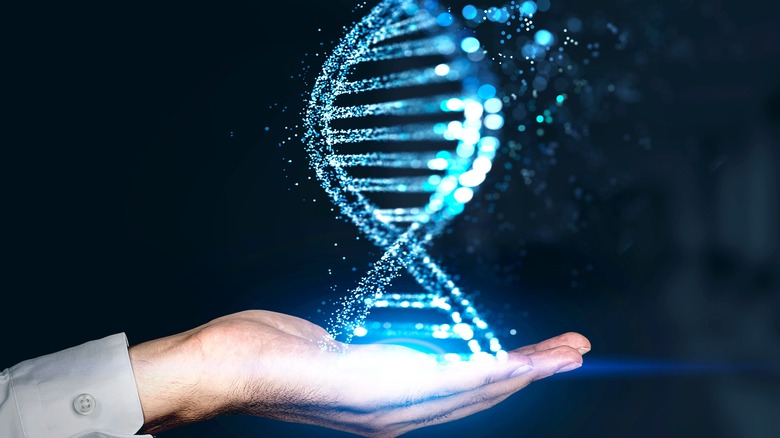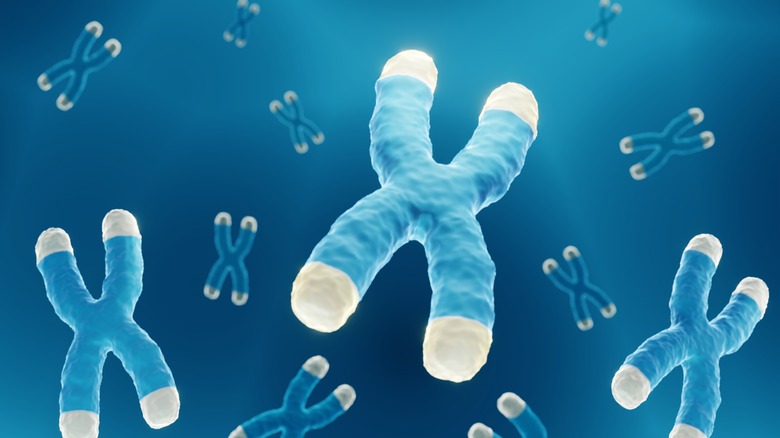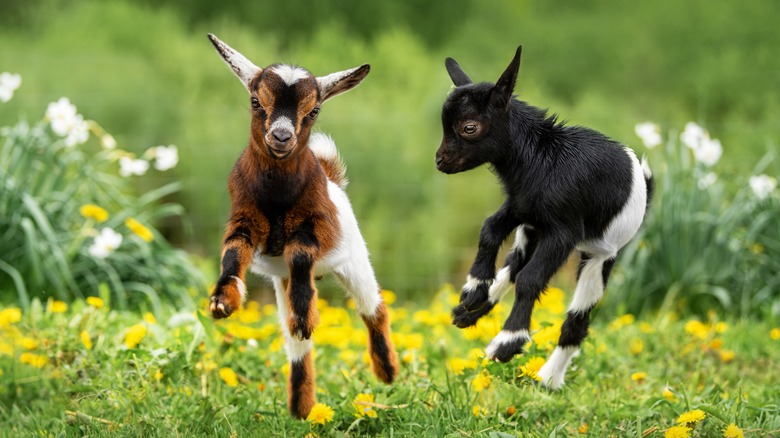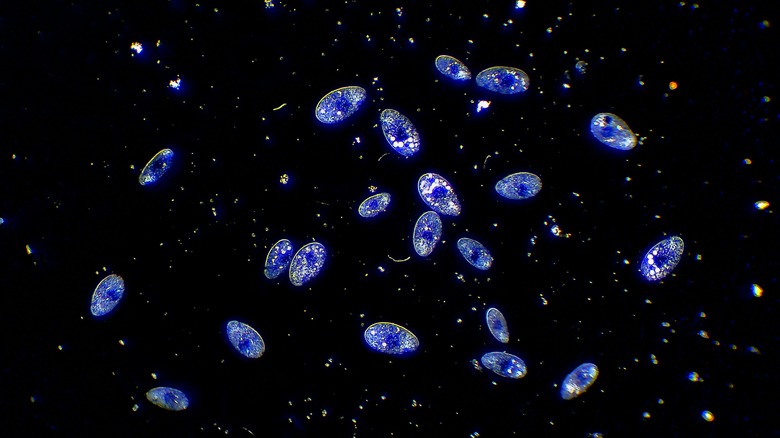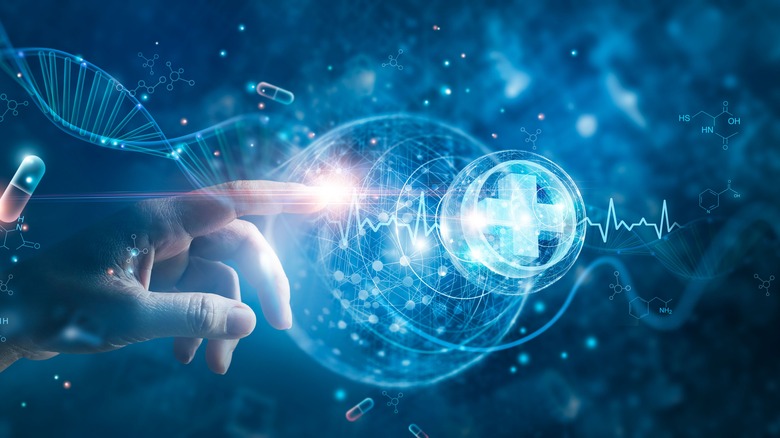How Human DNA Can Range From A Few Weeks To Thousands Of Years Old
Deoxyribonucleic acid, more commonly known as DNA, makes us who we are. It is the molecule that contains our genetic information, which allows for our cells to operate and allow us to live. Nearly all life on Earth utilizes DNA for this purpose, and it's what comprises our genes, according to Medline Plus. DNA is made up of four different bases: Guanine, adenine, cytosine, and thymine. Adenine and thymine pair together, whereas cytosine and guanine do the same. When combined, these molecules form base pairs, which are also combined with a sugar molecule and a phosphate, creating a nucleotide. This creates the famous double helix structure that people often associate with DNA (via Medline Plus).
Given DNA's ability to replicate itself, it creates our genes. Genes are the information that creates proteins, the prime source of what makes our cells run (via the National Human Genome Research Institute). However, eventually all people die, and that includes their DNA as well. As people's bodies decompose, so does their DNA, but just how long does the molecule actually survive? Well, it's complicated (via the Investigative Sciences Journal).
Inception
For starters, to understand the lifespan of DNA, it is important to understand where the molecule begins. As stated before, DNA is comprised of bases that code our genetic information, called genes, which are then sent out to proteins to carry on with all the tasks our bodies need to regulate themselves. However, these genes are contained in structures called chromosomes. In the human genome, there are 23 pairs of chromosomes (via The Jackson Laboratory). Chromosomes create an X-like shape, and are protected at the top by something called a telomere, which acts as a capsule to contain our genes through cell division. The chromosomes allow our DNA to safely replicate and copy itself so it won't be contaminated or ruptured by other cell functions, states The Jackson Research Laboratory.
Then comes meiosis, which creates the gametes, or the reproductive cells. As a cell goes through meiosis, two chromosomes replicate themselves and go through a process called recombination to exchange genetic information. Eventually, after enough cell division occurs, four haploid cells are formed (via Your Genome).
Fertilization for plants
The reproductive cells take different forms for the two sexes. Male gametes are sperm cells, and female gametes are egg, or ova, cells (via Nature). Sperm cells tend to be significantly smaller than their female counterparts, and they also have a tail to increase mobility. They combine in a process called fertilization, and it operates quite differently for plants and animals (per Britannica). Plant cells are fertilized by pollination, the process of pollen coming into contact with a macrospore, according to Britannica. This is carried out by outside agents such as bees, butterflies, or even the wind, according to the U.S. Department of Agriculture.
Interestingly enough, most plants have both male and female reproductive cells. These self-fertilizing plants are divided into two categories: hermaphroditic and monoecious. Hermaphroditic plants have flowers with the ability to both produce pollen and have egg cells to receive the pollen. Monoecious plants grow flowers that are either male or female, but given the fact that they still come from the same plant, it is considered self-fertilization (via Frontiers).
Fertilization for animals
For animals, including humans, the process is different. A female egg cell is fertilized when a single sperm cell, also known as a spermatozoon, comes into contact with the egg's membrane (via Britannica). After this, the zygote is formed, which then creates a new individual with a whole new set of combined genetics. The membrane almost immediately changes to block access from being fertilized by any other sperm cells. In addition to this, the egg cell is "activated," meaning it's able to divide and reproduce, creating a new individual (via Britannica).
Some animals don't need the sperm cell and the egg cell to combine to lay eggs, however, and species like bees often activate their egg cells by other means besides sexual reproduction. Other animal species sometimes have multiple sperm cells enter the egg cell at once, but only one spermatozoon fertilizes the female gamete and the others are killed, according to Britannica.
Billions of years old
So, discussing the lifespan of DNA is a complicated question, and it depends heavily on your framing. If you are just taking into account the genetic information inscribed on the molecule, your DNA would be billions of years old. Think of your genetic makeup for a second. You are the combination of two different haploid cells, both with their own DNA, which came from your parents. Those haploid cells were created by an individual who was also created via the same process as you, and so on. Therefore, given that life is approximately 3.7 billion years old (per Smithsonian), your oldest DNA would be around that age.
If you are talking about individual cells that contain the DNA, the lifespan decreases dramatically. Some cells live only a few short days, whereas others can live to be 10 years old, according to Discovery. DNA can also be preserved after death, and how many outside factors come into contact with the molecule determines how long it can survive (via Investigative Sciences Journal).
Leaving your mark
DNA that comes from hair, blood, or saliva, for example, is extremely prone to be damaged by heat and sunlight, according to Investigative Sciences Journal. If a body is buried underground, however, then scientists can take DNA from the bones or teeth of the subject thousands of years after they have died (via the Investigative Sciences Journal). Even more notably, DNA can be frozen and preserved in ice for hundreds of thousands of years.
Reading DNA is vital to many different groups and organizations. Analyzing DNA can help you understand your family ancestry. It is also useful in lab studies, as well as criminal investigations directed toward finding people who have committed crimes. It can also help find missing persons, and be useful in all sorts of other measures, too (via the Investigative Sciences Journal). We all have a trace going billions of years back, and perhaps we'll continue leaving our genetic imprint for billions more to come.
